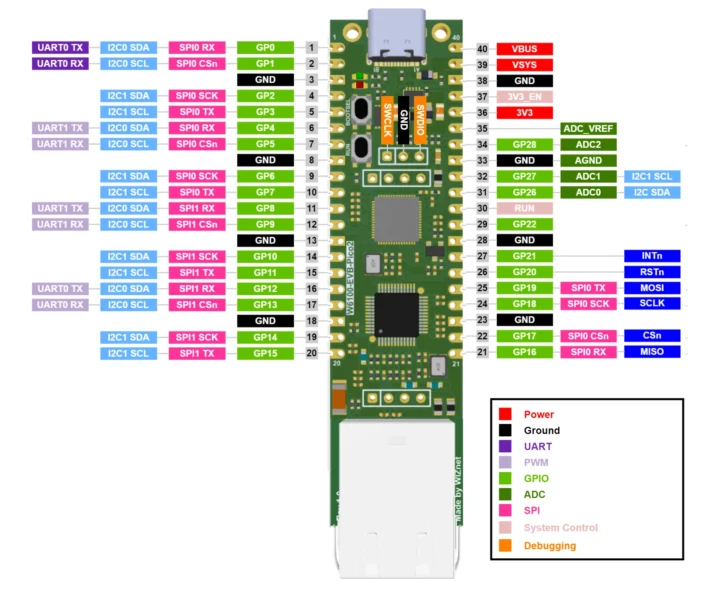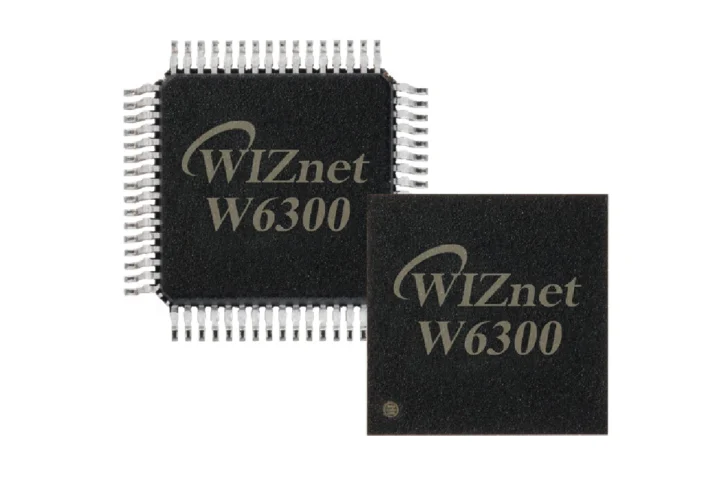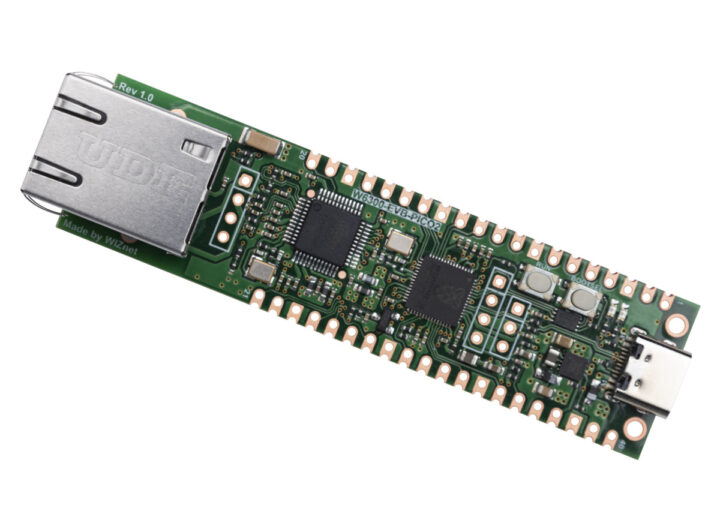WIZnet W6300-EVB-Pico2 is a development board that combines a Raspberry Pi RP2350 MCU with the company’s new W6300 QSPI Ethernet controller capable of 80+ Mbps data rates.
WIZNet has made several 10/100Mbps Ethernet controllers over the years that connect to microcontrollers via SPI, but the speed is often limited to 15 to 70 Mbps due to a low SPI clock frequency and small buffers. The WIZNet W6300 Ethernet controller can deliver higher speed thanks to a 150MHz system clock, a QSPI interface with four data lines, 64KB SRAM, and 4KB TX/RX buffer for each of the 8 sockets.
W6300 QSPI Ethernet controller
W6300 features and specifications:
- Host Interface – High-speed QSPI (MODE 0/3), system bus with 2 address signals & 8-bit data
- Internal 32KB SRAM for Tx/ Rx buffers (64KB in total)
- 8x independent sockets with 64KB Memory
- 10BaseT / 10BaseTe / 100BaseTX Ethernet PHY Integrated
- Auto negotiation (Full and half-duplex, 10 and 100-based)
- Auto-MDIX only on Auto-Negotiation Mode
- IP Fragmentation not supported
- Hardwired TCP/IP protocols – TCP, UDP, IPv6, IPv4, ICMPv6, ICMPv4, IGMP, MLDv1, ARP, PPPoE
- IPv4/IPv6 dual stack
- Socket-less command support – ARP, PING, ICMPv6 (PING, ARP, DAD, NA, RS); commands for IPv6 auto-configuration & network monitoring
- Ethernet Power Down Mode & System Clock Switching for power saving
- Wake on LAN over UDP
- Network Indicator LEDs (Full/Half Duplex, Link, 10/100 Speed, Active)
- Supply Voltage – 3V operation with 5V I/O signal tolerance
- Package – 48-pin LQFP & QFN lead-free packages
Besides the SPI/QSPI interface, this type of Ethernet controller is suitable for microcontrollers because it features a TCP/IP Offload Engine (TOE) so all network operations at offloaded to the controller. The documentation website has more technical details, including a datasheet, reference schematics (PDF and Altium), Gerber files, and information about the W6300-EVB-Pico2 board on the company website.
W6300-EVB-Pico2 board with RP2350 MCU and W6300 Ethernet controller
The W6300-EVB-Pico2 board is similar to the W5100S-EVB-Pico2 and W5500-EVB-Pico2 boards with a Raspberry Pi RP2350 microcontroller coupled with a W5100S and W5500 Ethernet controller, but the new W6000-based board should deliver better Ethernet performance
W6000-EVB-Pico2 specifications:
- Microcontroller – Raspberry Pi RP2350A
- CPU – Dual-core Arm Cortex-M33 processor @ 150MHz (RISC-V cores are not mentioned)
- Memory – 520KB internal RAM
- 8KB OTP Storage
- Storage – 16Mbit SPI flash
- Ethernet – 10/100Mbps Ethernet RJ45 port via WIZnet W6300 “iEthernet” chip described above
- USB – 1x USB C-Type port for power, data, and programming
- Expansion – 2x 20-pin with through and castellated holes
-
- 2x UART, 2x SPI, 2x I2C
- 16x PWM
- 4x 12-bit 500ksps Analogue to Digital Converter (ADC)
- 3x Programmable IO (PIO) blocks, 12 state machines total
- HSTX peripheral
- 1x Timer with 4 alarms
- 1x Real Time Counter
-
- Security – OTP, Secure Boot, Arm TrustZone
- Debugging – 3-pin SWD header
- Power Supply
- Built-in Switch-mode DC-DC converter
- VBUS – DC 5V (+/- 10%)
- VSYS – 4.3V to 5.5V
- Dimensions – 80 x 20mm
- Temperature Range – -20°C to +85°C (up to 70°C recommended)
- Certifications – CE/FCC

The documentation for the W6300-EVB-Pico2 is a work-in-progress, so I included the pinout diagram for the W6100-EVB-Pico2 above as it should be identical or close to the one for the upcoming W6300-EVB-Pico2. There’s no code yet, but the company typically provides C samples for their chips and boards, and they eventually get ported to Arduino libraries.
WIZnet has just unveiled the W6300 chip via a post on X, so I assume it’s available now or will soon be, and the W6100-EVB-Pico2 board should follow suit. The company usually sells their chips and evaluation board via its online store, but neither are listed yet. Additional information may be found on the product pages for the new iEthernet chip and the development board.

Jean-Luc started CNX Software in 2010 as a part-time endeavor, before quitting his job as a software engineering manager, and starting to write daily news, and reviews full time later in 2011.
Support CNX Software! Donate via cryptocurrencies, become a Patron on Patreon, or purchase goods on Amazon or Aliexpress






